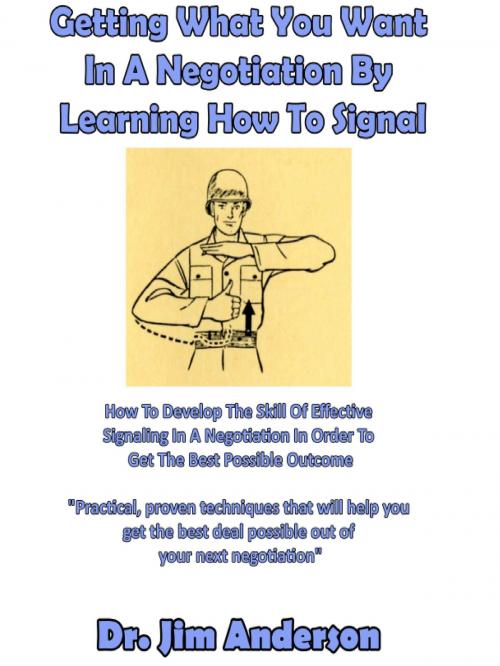Getting What You Want In A Negotiation By Learning How To Signal: How To Develop The Skill Of Effective Signaling In A Negotiation In Order To Get The Best Possible Outcome
Business & Finance, Management & Leadership, Negotiating| Author: | Jim Anderson | ISBN: | 9781370191536 |
| Publisher: | Jim Anderson | Publication: | January 6, 2017 |
| Imprint: | Smashwords Edition | Language: | English |
| Author: | Jim Anderson |
| ISBN: | 9781370191536 |
| Publisher: | Jim Anderson |
| Publication: | January 6, 2017 |
| Imprint: | Smashwords Edition |
| Language: | English |
When we sit down to negotiate, we are really entering into a very specialized conversation with the other side of the table. We have a set of goals and they have their own set of goals. The purpose of the negotiation conversation is to find out if there is a way that the needs of both sides of the table can be met.
What You'll Find Inside:
* DEMANDS & DEADLINES: YOUR TWO BEST FRIENDS
* SAY HELLO TO THE BOGEY-MAN – A NEGOTIATOR’S BEST FRIEND
* NEGOTIATION FIRESTARTER: THE TAKE IT OR LEAVE IT TACTIC
* NEGOTIATING SELF DEFENSE: COUNTERING THE REVERSE AUCTION TACTIC
In order to find ways to move the negotiation forward, the other side is going to have to understand what we are trying to accomplish. They are going to have to know when something is important to us and when we really don't care about something. It is our obligation to communicate our intentions to the other side.
The way that we communicate what we want is by signaling to them. Signals are rarely spoken words. Instead, we need to find other ways to get our point across and let the other side know what we want them to do. This requires them to take the time to study us and to get to know us well enough to be able to pick up on our signals.
During a negotiation, signals can come in many different forms. One of the more common ones is a deadline. We may present the other side with a deadline in order to motivate them or they may present us with one. If we are facing a deadline, then we need to know how best to react to it in order to still be able to reach our negotiating goals.
A great way to become better at using signaling is to take the time to see how others use signaling in their negotiations. The classic example is in labor negotiations where both sides are using the press to attempt to communicate to the other side what they want them to do. In the past few years, Boeing has been involved in a number of negotiations and has done a very good job of signaling to the other side what the next steps need to be.
When we sit down to negotiate, we are really entering into a very specialized conversation with the other side of the table. We have a set of goals and they have their own set of goals. The purpose of the negotiation conversation is to find out if there is a way that the needs of both sides of the table can be met.
What You'll Find Inside:
* DEMANDS & DEADLINES: YOUR TWO BEST FRIENDS
* SAY HELLO TO THE BOGEY-MAN – A NEGOTIATOR’S BEST FRIEND
* NEGOTIATION FIRESTARTER: THE TAKE IT OR LEAVE IT TACTIC
* NEGOTIATING SELF DEFENSE: COUNTERING THE REVERSE AUCTION TACTIC
In order to find ways to move the negotiation forward, the other side is going to have to understand what we are trying to accomplish. They are going to have to know when something is important to us and when we really don't care about something. It is our obligation to communicate our intentions to the other side.
The way that we communicate what we want is by signaling to them. Signals are rarely spoken words. Instead, we need to find other ways to get our point across and let the other side know what we want them to do. This requires them to take the time to study us and to get to know us well enough to be able to pick up on our signals.
During a negotiation, signals can come in many different forms. One of the more common ones is a deadline. We may present the other side with a deadline in order to motivate them or they may present us with one. If we are facing a deadline, then we need to know how best to react to it in order to still be able to reach our negotiating goals.
A great way to become better at using signaling is to take the time to see how others use signaling in their negotiations. The classic example is in labor negotiations where both sides are using the press to attempt to communicate to the other side what they want them to do. In the past few years, Boeing has been involved in a number of negotiations and has done a very good job of signaling to the other side what the next steps need to be.















